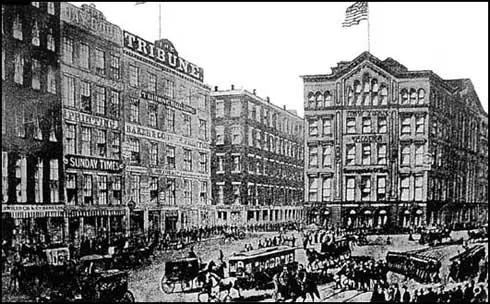New York Times
The New York Times was established in 1851. The main objective of the newspaper was to report the news in a restrained and objective fashion. It enjoyed early success by appealing to a cultured, intellectual readership instead of a mass audience.
In 1871 the New York Times joined with Thomas Nast and Harper's Weekly to expose the corruption of William Tweed, the political boss of New York. On 21st July, the newspaper published the contents of the New York County ledger books. This revealed that thermometers were costing $7,500 and brooms were being charged at a staggering $41,190 apiece. Tweed's friends were commissioned to do the work. George Miller, a carpenter, was paid $360,747 for a month's labour, whereas James Ingersoll received $5,691,144 for furniture and carpets. As a result of this investigation, Tweed was convicted and imprisoned for corruption.
In the 1890s the New York Times found it difficult to compete with newspapers such as those owned by Joseph Pulitzer and William Randolph Hearst. The New York World and the New York Journal concentrated on human-interest stories, scandal and sensational material. This yellow journalism appeared to be what the New York public wanted and the sales of the New York Times began to fall and by the mid 1890s the newspaper was losing $1,000 a week.

the right and the Tribune is in the centre (1865)
In 1896 the New York Times was purchased by Adolph Ochs. It was no longer the force it was and now had the smallest circulation of the city's eight morning daily newspapers. Ochs announced to his readers that: "It will be my earnest aim that the New York Times give the news, all the news, in concise and attractive form". Ochs also adopted some of the methods used by Joseph Pulitzer and William Randolph Hearst, such as the inclusion of magazine supplements. However, the newspaper continued to report the news in a restrained and objective manner.
Ochs cut the price of the New York Times from three cents to one cent, and attracted readers from the tabloid press. However, he made it clear he had no intention of competing with the unscrupulous newspapers by declaring on his front-page: "All the News That's Fit to Print". The strategy was successful and circulation jumped from 25,000 in 1898 to 100,000 in 1901.
In 1904 Adolph Ochs appointed Carr Van Anda as managing editor. Obsessed with reporting every major story in great detail, Ochs worked twelve hours a day, seven days a week. As one historian of the newspaper has pointed out: "He loved to match his speed and wits against a deadline. But he never lost sight of the importance of conscientious and intelligent handling of the bulk of the news, and he transmitted this spirit to his staff."
One of Van Anda's many success stories was the way he reported the sinking of the Titanic. At 1:20 a.m. on 15th April, 1912, the New York Times newsroom received information about the Titantic SOS via the Marconi wireless station in Newfoundland. Van Anda contacted his correspondents in Halifax and Montreal who were able to find out that the ship's wireless had fallen silent 30 minutes after the first call for help. By consulting the New York Times detailed news library Van Anda discovered that other ships had recently reported close scrapes with icebergs in this area. The next morning the New York Times reported on its front page that the ship had sunk while other papers in America were handling the story in incomplete and inconclusive manner.
During the First World War the New York Times began to publish the texts of documents and speeches in full. The compilation of the New York Times Index ensured that it became the nation's leading reference newspaper for students, librarians, historians, and journalists.
The newspaper continued to prosper under Adolph Ochs and Carr Van Anda and by 1921 circulation had reached 330,000 during the week and 500,000 on Sunday. At the same time advertising had increased tenfold in 25 years.
